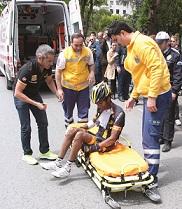

Basic needs
At any event, certain needs are clear, only the scope and size of the event will alter the implementation of those needs. General medical surveillance, to provide a safety net for the health and welfare of all present, is a basic need. There need to be adequate sites to address common issues which might arise. These would include ,falls, dehydration, infectious , potentially serious cardiac or respiratory conditions and potential interpersonal events such as attacks or assaults.
Appropriate plans need to be made for the ambient temperature and weather conditions. Heat, cold, rain or snow all require adjustment of facilities to protect those in attendance. Medical and aid stations must be visible and well-marked, and staffed with personnel appropriate to the event and anticipated problems. Depending on the population, accommodations for language, disability, or special needs of the population should be taken into account.
If the event is spread out over a larger geographic area, such as with a marathon or walk-a-thon, such stations can be stratified into higher and lower levels of care. In such an environment, secure and reliable communication from station to station and from station to base is critical. Transportation must be available for movement of involved parties to appropriate aid facilities within the event confines, or off site to Emergency Medical Services if needed, promptly and efficiently.
Running Into Trouble
Certainly, running has become one of the more popular pastimesparticularly on tracks and city streets. The nature of running brings its own set of issues to the forefront. It begins with feet. Feet sweat, feet blister, feet bleed and feet break. Any medical system set up to manage a race or walk must be prepared to deal with all of these issues. Aid stations need to have clear protocols to examine and evaluate participants’ feet.

Put people together in a game, baseball, football, basketball, tennis or any game with moving objects and potential personal contact, and the risk of injury rises significantly. Although predicting who will hurt what is impossible, preparing for likely injuries is prudent and necessary. When balls, bats, pucks or racquets hit players, you have the risk of pain, bruising, bleeding, fractures or concussions. Personnel at the facilities must have training and expertise to deal with such injuries, and evaluate for more serious occult damage. Triage of potentially serious injuries to secondary or tertiary facilities must be accomplished quickly to minimize complications.
Eye injuries are a special case which must be planned for. Acute trauma to the eye can cause a range of injuries from direct corneal injury through rupture of the globe of the eye or fracture of the orbit. Appropriate equipment should be available to adequately evaluate an eye injury upon presentation, with specialty care proximate to the event to minimize the possibility of permanent visual impairment.
Bones stressed to the breaking point create another group of problems. If the venue is large enough, perhaps portable radiology could be available. At a minimum, materials for stabilizing possible fractures and mechanisms for transporting patients to sites of definitive care quickly and efficiently need to be present.
Head injuries are recognized as potentially serious events, with the possibility of a concussion often minimized or overlooked. There are clear guidelines and protocols for dealing with head injuries, with screening for concussion required before returning to activity. Such screening should be mandatory after any head injury, with the decision to return to activity requiring a completely normal screen and clearance by a trained medical individual. Any suspicion that there is a significant head injury should be dealt with completely and thoroughly.
And then there is such a little thing that can cause such a great problem. Stings and allergies can bring down an athlete or spectator seemingly without warning. Suitable emergency measures, from epinephrine to steroids, should be available along with those trained to use them. Again, depending on the size of the venue, such treatment modalities may need to be distributed among many aid centers. In the case of an anaphylactic reaction, a delay of minutes can be serious.
Just watching can be dangerous
Although much attention is properly paid to the participants of sporting events, those watching are often at risk as well. From the baseball flying into the stands to the slightly inebriated guest not paying attention to his or her surroundings, emergencies can surface at any time, at any place. Again, the type of event and venue would dictate whether local aid stations would accommodate both spectators and participants, or if there were some dedicated facility to at least triage individuals, such as in a stadium or confined field. In any case, clear and legible signage should be posted to enable those in need, whether spectators, participants, press or others in attendance, to quickly locate aid facilities.

In the case of Little League, Pop Warner, or other such events involving younger children, special precautions need to be taken to insure the safety of the most vulnerable. Younger participants may not have the expertise or training to approach an activity safely, resulting in a range of potential injury. Youngsters can also be subject to stresses and falls, with consequences including bumps, bruises, and broken bones. Fractures across the growth plate of a growing bone are very serious, and need to be attended to by expert personnel. Stabilization and triage again come into play.
You’ve gotta have heart
As with the young, older participants and spectators constitute a special case. Between the stress of participation and the excitement of observation, a very real potential for a cardiac event exists at a sporting event. There are multiple recorded instances of people present in all capacities collapsing with a sudden coronary event. With proper planning and support, these need not be fatalities.
One of the basic devices which should be available is the Automated External Defibrillator (AED). These devices can analyze a heartbeat for abnormalities and deliver a life-saving shock at just the right time. They are simple to use, often talking the user through the steps. Within the critical few minutes of time following a collapse, one should be within range for use at any event. Clearly, that may mean only one at a small, confined venue, but several would likely be needed if the scope of the event covers more area. One AED back at the center is of no help if it takes ten minutes to get to an individual who is down.
Similarly, depending on the composition of the population, having one or more trained EMTs may be in order. Other paramedical personnel can function autonomously for the bulk of problems. Ultimately, there should be a physician to deal with any complex or dangerous cases, as well as act as the “point person” in triage situations.
It is likely impossible to completely predict the range of medical situations which may present during a sporting event. Nonetheless, with a capable core staff, experienced in emergency medical procedures, structured facilities appropriate to the venue and volume of potential problems, and protocols and plans for triage and transport to definitive destinations one can do the best to minimize problems.

